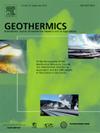云南地热水评价:分布、水质及驱动因素
IF 3.5
2区 工程技术
Q3 ENERGY & FUELS
引用次数: 0
摘要
地热能是一种重要的可再生资源,广泛应用于各种用途,包括饮用水、家庭供水、灌溉和工业用途。然而,利用地热水饮用可能使个人接触有毒元素,特别是砷,这对健康构成重大威胁。尽管人们对地热水的兴趣日益浓厚,但对地热水质量和健康风险的空间变异性缺乏系统的分析。本研究采用水化学和同位素方法、主成分分析(PCA)、自组织图(SOM)以及水质指数(WQI)和人类健康风险评估(HHRA)等综合工具,对云南省水质特征和健康风险的空间变异性进行评价,以弥补这一空白。研究认为,大气降水是云南地热水补给的主要来源,Na-HCO3、Ca-HCO3、Na-Cl和Ca-Cl是云南地热水水化学的主要来源。大部分样本水质良好,而西北地区(丽江、临沧、昆明、宝山、景洪、普洱和大理)的水质较差,存在较大的健康风险。主成分分析表明,地热水水质的空间变异在很大程度上受深部水循环和岩浆-构造相互作用的影响,导致砷在高危区富集。本研究弥补了云南省地热水水质空间变异性和健康风险评价的研究空白,为可持续发展和管理提供科学依据。本文章由计算机程序翻译,如有差异,请以英文原文为准。

Assessment of geothermal waters in Yunnan, China: Distribution, quality and driving factors
Geothermal energy is a vital renewable resource widely used for various applications, including drinking water, domestic supply, irrigation, and industrial purposes. However, the utilization of geothermal water for drinking can expose individuals to toxic elements, particularly arsenic, which poses significant health risks. Despite the growing interest in geothermal water, there has been a lack of systematic analysis regarding the spatial variability of its quality and health risk. This study aims to address this gap by evaluating the spatial variability of the water quality characteristics and health risks in Yunnan Province using a combination of hydrochemical and isotopic methods, Principal Component Analysis (PCA), Self-Organizing Maps (SOM) and integrated tools such as Water Quality Index (WQI) and Human Health Risk Assessment (HHRA). According to this study, atmospheric precipitation serves as the primary recharge source with Na-HCO3, Ca-HCO3, Na-Cl and Ca-Cl as the dominant geothermal water hydrochemical in Yunnan Province. While most samples exhibit good water quality, those from the northwestern regions (e.g., Lijiang, Lincang, Kunming, Baoshan, Jinghong, Pu'er, and Dali) show poorer water quality and significant health risks. PCA analysis reveals that the spatial variability of geothermal water quality is largely influenced by deep hydrological cycles and magma-tectonic interactions, resulting in arsenic enrichment in high-risk areas. This study addresses the research gap regarding the spatial variability of geothermal water quality and health risk assessment in Yunnan Province and provides a scientific foundation for sustainable development and management.
求助全文
通过发布文献求助,成功后即可免费获取论文全文。
去求助
来源期刊

Geothermics
工程技术-地球科学综合
CiteScore
7.70
自引率
15.40%
发文量
237
审稿时长
4.5 months
期刊介绍:
Geothermics is an international journal devoted to the research and development of geothermal energy. The International Board of Editors of Geothermics, which comprises specialists in the various aspects of geothermal resources, exploration and development, guarantees the balanced, comprehensive view of scientific and technological developments in this promising energy field.
It promulgates the state of the art and science of geothermal energy, its exploration and exploitation through a regular exchange of information from all parts of the world. The journal publishes articles dealing with the theory, exploration techniques and all aspects of the utilization of geothermal resources. Geothermics serves as the scientific house, or exchange medium, through which the growing community of geothermal specialists can provide and receive information.
 求助内容:
求助内容: 应助结果提醒方式:
应助结果提醒方式:


